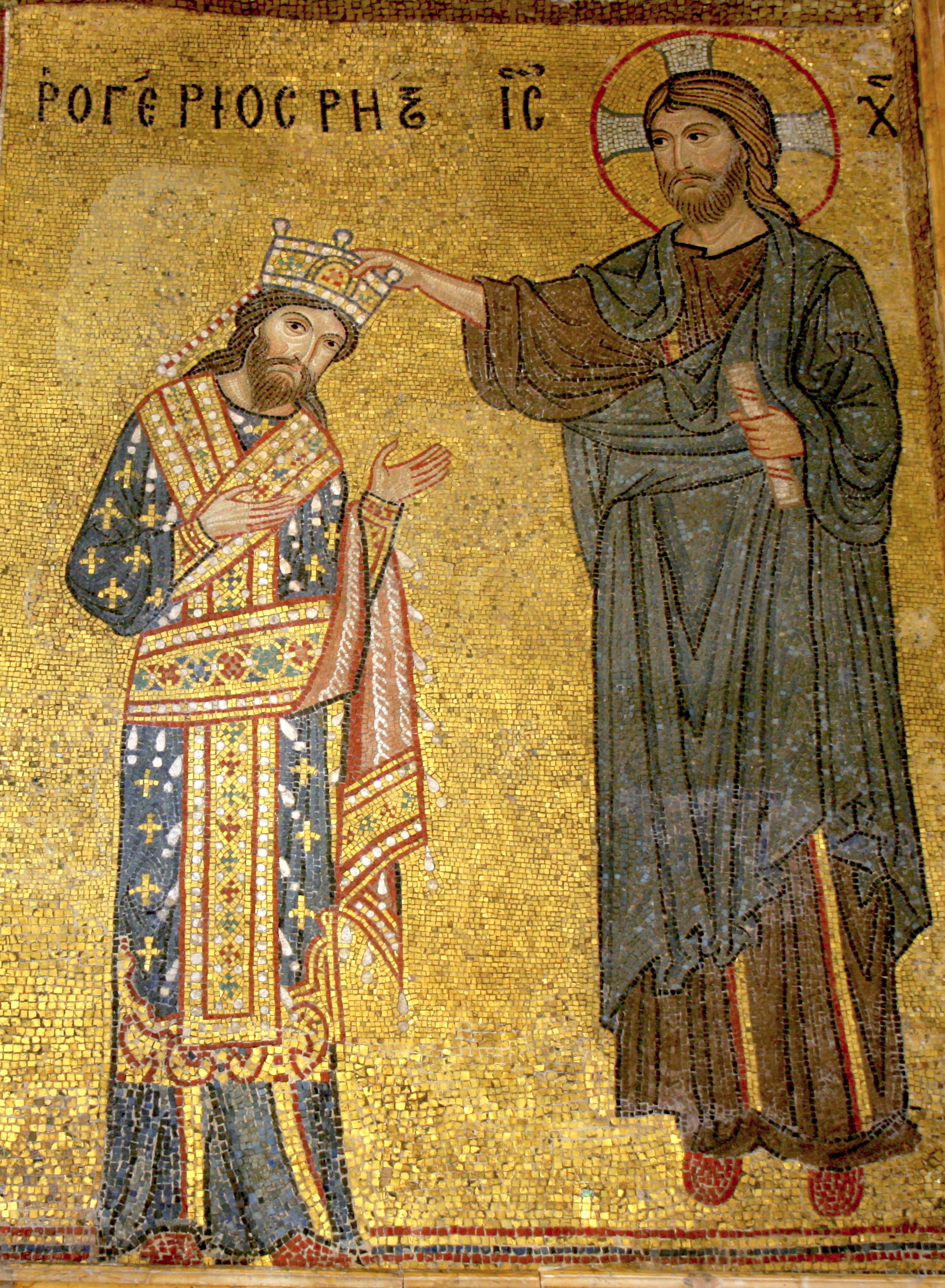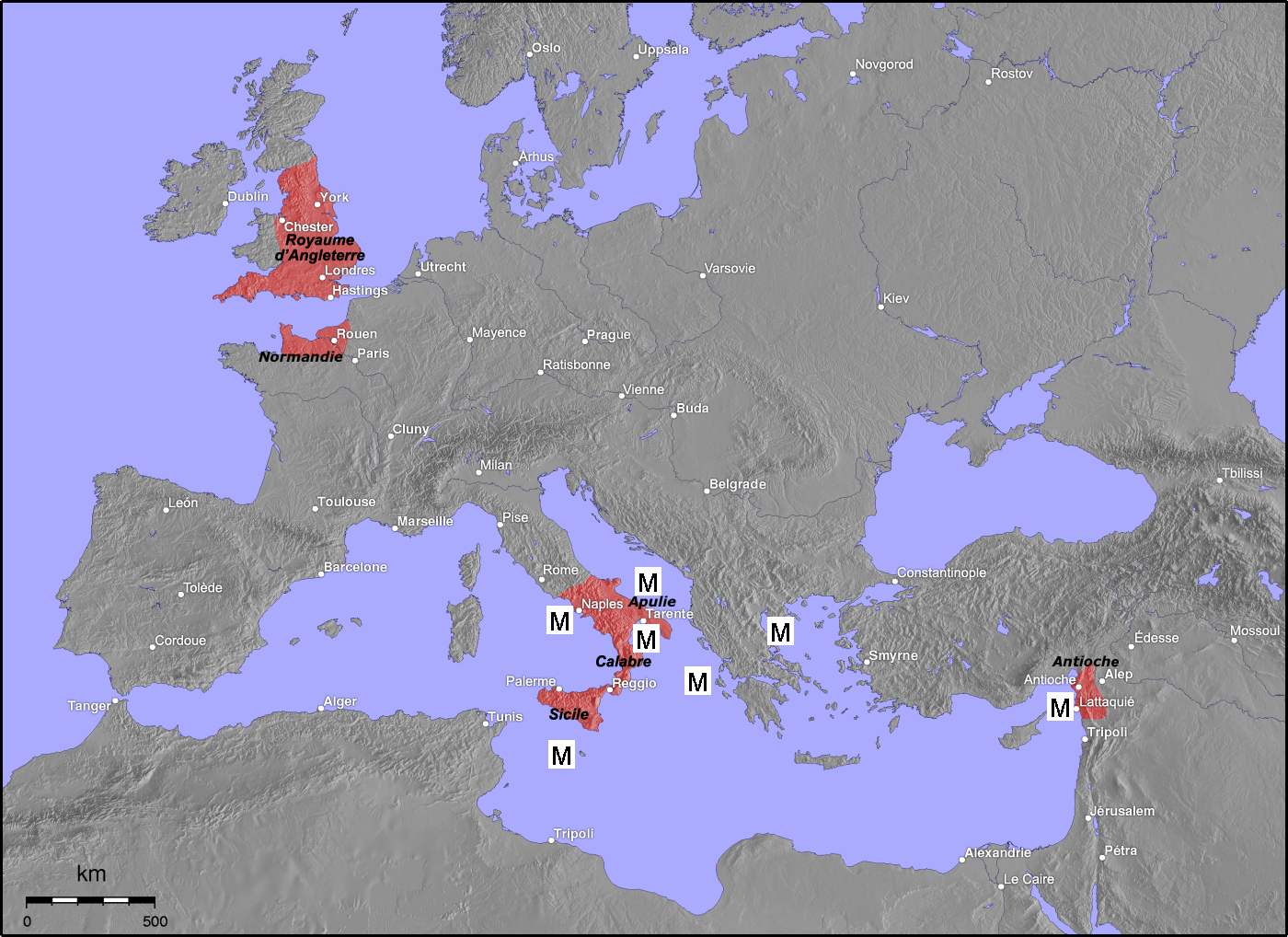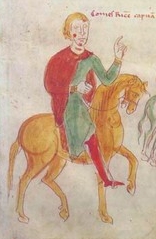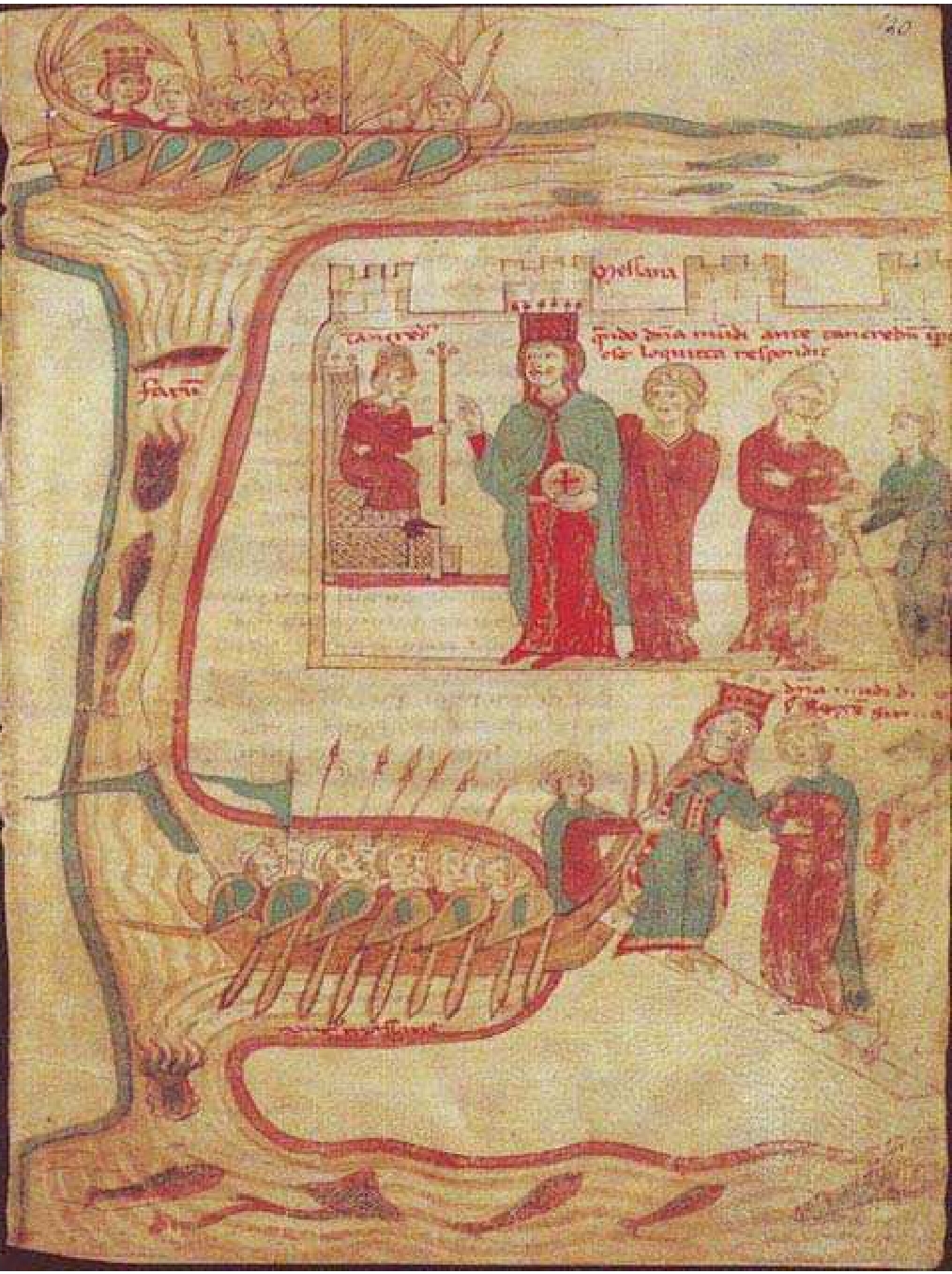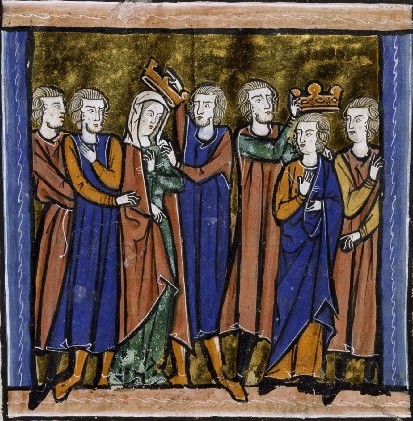|
Tancred Of Lecce
Tancred (; 113820 February 1194) was King of Sicily from 1189 to 1194. He was born in Lecce, an illegitimate son of Roger III, Duke of Apulia (the eldest son of King Roger II) by his mistress Emma, a daughter of Achard II, Count of Lecce. He inherited the title "Count of Lecce" from his grandfather and is consequently often referred to as Tancred of Lecce. Due to his short stature and unhandsome visage, he was mocked by his critics as "The Monkey King". Early career After the death of Duke Roger, to prevent any future trouble, King Roger II kept Tancred and his younger brother William in close custody in Palermo. On 9 March 1161, Tancred joined his uncle Simon, Prince of Taranto, in invading the palace, detained the king and queen, William I and Margaret, and their two sons, and incited a massacre of Muslims. Originally, the older of these two sons, Roger IV, Duke of Apulia, was destined to be crowned in place of William, but soon the populace supported the accession o ... [...More Info...] [...Related Items...] OR: [Wikipedia] [Google] [Baidu] |
King Of Sicily
The monarchs of Sicily ruled from the establishment of the Kingdom of Sicily in 1130 until the "perfect fusion" in the Kingdom of the Two Sicilies in 1816. The origins of the Sicilian monarchy lie in the Norman conquest of southern Italy which occurred between the 11th and 12th century. Sicily, which was ruled as an Islamic Emirate of Sicily, emirate for at least two centuries, was invaded in 1071 by Normans, Norman House of Hauteville, who conquered Palermo and established a feudal county named the County of Sicily. The House of Hauteville completed their conquest of Sicily in 1091. In 1130, the County of Sicily and the County of Apulia, ruled by different branches of the House of Hauteville, merged as the Kingdom of Sicily, and Count Roger II of Sicily, Roger II was crowned king by Antipope Anacletus II. In 1282, after the Sicilian Vespers, the kingdom split into separate states: the properly named "Ultra Sicily" (''Siciliae ultra Pharum'', Latin for "Sicily over the Strait of M ... [...More Info...] [...Related Items...] OR: [Wikipedia] [Google] [Baidu] |
Simon, Prince Of Taranto
Simon, bastard son of Roger II of Sicily, was declared Prince of Taranto by his father in 1148, on the death of Roger III, Duke of Apulia, the eldest legitimate son of Roger II. In 1154, Roger II died and the kingdom of Sicily passed to his fourth son, William I. William dispossessed his half-brother Simon immediately, claiming that Taranto was too important a fief to go to an illegitimate son. Simon held a grudge against the king and was called upon by Matthew Bonnellus to lead the revolt in the capital city of Palermo in 1161. This Simon did, with his nephew, Tancred of Lecce Tancred (; 113820 February 1194) was King of Sicily from 1189 to 1194. He was born in Lecce, an illegitimate son of Roger III, Duke of Apulia (the eldest son of King Roger II) by his mistress Emma, a daughter of Achard II, Count of Lecce. H ..., the bastard son of Roger of Apulia, on 9 March. Simon and Tancred invaded the palace, detained King William, Queen Margaret, and their two sons, and incited ... [...More Info...] [...Related Items...] OR: [Wikipedia] [Google] [Baidu] |
Margaritus Of Brindisi
Margaritus of Brindisi (also Margarito; Italian language, Italian: ''Margaritone'', Greek language, Greek: ''Megareites'' or ''Margaritoni'' [Μαργαριτώνη]; c. 1149 – 1197), called "the new Neptune", was the last great ''ammiratus ammiratorum'' (Grand Admiral) of the Kingdom of Sicily. Following in the footsteps of Christodulus, George of Antioch, and Maio of Bari, Margaritus commanded the kingdom's fleets during the reigns of William II of Sicily, William II (1166–1189) and Tancred of Sicily, Tancred (1189–1194). He probably began as a Greeks, Greek pirate and gradually rose to the rank of privateer before becoming a permanent admiral of the navy. In 1185, he became the first County Palatine of Cephalonia and Zakynthos, count palatine of Cephalonia and Zakynthos. In 1192, he became the first Count of Malta. Biography Margaritus first appears in the historical record as a leader of the Sicilian fleet alongside Tancred, then Count of Lecce, which took th ... [...More Info...] [...Related Items...] OR: [Wikipedia] [Google] [Baidu] |
Isaac II
Isaac II Angelos or Angelus (; September 1156 – 28 January 1204) was Byzantine Emperor from 1185 to 1195, and co-Emperor with his son Alexios IV Angelos from 1203 to 1204. In a 1185 revolt against the Emperor Andronikos Komnenos, Isaac seized power and rose to the Byzantine throne, establishing the Angelos family as the new imperial dynasty. His father Andronikos Doukas Angelos was a military leader in Asia Minor (c. 1122 – aft. 1185) who married Euphrosyne Kastamonitissa (c. 1125 – aft. 1195). Andronikos Doukas Angelos was the son of Constantine Angelos and Theodora Komnene (b. 15 January 1096/1097), the youngest daughter of Emperor Alexios I Komnenos and Irene Doukaina. Thus Isaac was a member of the extended imperial clan of the Komnenoi. Rising by revolt Niketas Choniates described Isaac's physical appearance: "He had a ruddy complexion and red hair, was of average height and robust in body". During the brief reign of Andronikos I Komnenos, Isaac ... [...More Info...] [...Related Items...] OR: [Wikipedia] [Google] [Baidu] |
Richard, Count Of Acerra
Richard, count of Acerra (died 30 November 1196) was an Italo-Norman nobleman, grandson of Robert of Medania, a Frenchman of County of Anjou, Anjou. Brother of Sibylla of Acerra, Sibylla, queen of Tancred of Sicily, Richard was the chief peninsular supporter of his brother-in-law during his claim for the throne in 1189. Biography Richard was the co-commander of the army attached to Tancred's fleet in 1185. They captured Durrës, Durazzo from the Byzantine Empire without a struggle. The city had fully surrendered by June 24. Richard then led his army on a march across the Balkan peninsula and by August 6 he had begun his Sack of Thessalonica (1185), Siege of Thessalonica. On August 24 Thessalonika fell to Richard's armies in its turn. But Richard was defeated and captured at Battle of Demetritzes. In 1190, Richard was charged with keeping the Germans, German supporters of Roger of Andria out of Apulia. Richard secured all Apulia and the Terra di Lavoro. Richard then "raised a g ... [...More Info...] [...Related Items...] OR: [Wikipedia] [Google] [Baidu] |
Constance I Of Sicily
Constance I (; 2 November 1154 – 27 November 1198) was the queen of Sicily from 1194 until her death and Holy Roman empress from 1191 to 1197 as the wife of Emperor Henry VI. As queen regnant of Sicily, she reigned jointly with her spouse and later with her infant son, the future Holy Roman Emperor Frederick II. She is particularly notable for her actions against her own family, the Norman kings of Sicily; she played an important role in the end of the Hauteville presence in Sicily. Despite being the sole heir to the throne of Sicily, she did not marry until she was 30 due to an ominous prophecy. Shortly after becoming empress, she was involved in the succession war against her illegitimate nephew King Tancred for the Sicilian throne, during which she was captured, though she was later released unharmed. In the history of Holy Roman Empire only two empresses were captured, with the other being her mother-in-law Empress Beatrice. Shortly before ascending the Sicilian thron ... [...More Info...] [...Related Items...] OR: [Wikipedia] [Google] [Baidu] |
Steven Runciman
Sir James Cochran Stevenson Runciman (7 July 1903 – 1 November 2000), known as Steven Runciman, was an English historian best known for his three-volume '' A History of the Crusades'' (1951–54). His works had a profound impact on the popular conception of the Crusades. Biography Born in Northumberland, he was the second son of Walter and Hilda Runciman. His parents were members of the Liberal Party and the first married couple to sit simultaneously in Parliament. His father was created Viscount Runciman of Doxford in 1937. His paternal grandfather, Walter Runciman, 1st Baron Runciman, was a shipping magnate. He was named after his maternal grandfather, James Cochran Stevenson, the MP for South Shields. Eton and Cambridge Runciman said that he started reading Greek at the age of seven or eight. Later he came to be able to make use of sources in other languages as well: Arabic, Turkish, Persian, Hebrew, Syriac, Armenian and Georgian. A King's Scholar at Eton College, h ... [...More Info...] [...Related Items...] OR: [Wikipedia] [Google] [Baidu] |
Saladin
Salah ad-Din Yusuf ibn Ayyub ( – 4 March 1193), commonly known as Saladin, was the founder of the Ayyubid dynasty. Hailing from a Kurdish family, he was the first sultan of both Egypt and Syria. An important figure of the Third Crusade, he spearheaded the Muslim military effort against the Crusader states in the Levant. At the height of his power, the Ayyubid realm spanned Egypt, Syria, Upper Mesopotamia, the Hejaz, Yemen, and Nubia. Alongside his uncle Shirkuh, a Kurdish mercenary commander in service of the Zengid dynasty, Saladin was sent to Fatimid Egypt in 1164, on the orders of the Zengid ruler Nur ad-Din. With their original purpose being to help restore Shawar as the vizier to the teenage Fatimid caliph al-Adid, a power struggle ensued between Shirkuh and Shawar after the latter was reinstated. Saladin, meanwhile, climbed the ranks of the Fatimid government by virtue of his military successes against Crusader assaults and his personal closeness to al-Adid. A ... [...More Info...] [...Related Items...] OR: [Wikipedia] [Google] [Baidu] |
Amalric I Of Jerusalem
Amalric (; 113611 July 1174), formerly known in historiography as , was the king of Jerusalem from 1163 until his death. He was, in the opinion of his Muslim adversaries, the bravest and cleverest of the crusader kings. Amalric was the younger son of King Fulk and Queen Melisende and brother of King Baldwin III. Baldwin was crowned with Melisende after Fulk's death in 1143. Melisende made Amalric the count of Jaffa, and he took her side in her conflict with Baldwin until Baldwin deposed her in 1152. From 1154 Amalric was fully reconciled with his brother and made count of both Jaffa and Ascalon. In 1157 he married Agnes of Courtenay despite the misgivings of the Church and had two children with her, Sibylla of Jerusalem, Sibylla and Baldwin IV of Jerusalem, Baldwin. When his brother died in 1163, Amalric was obliged to leave Agnes in order to be recognized as king. He was crowned on 18 February. Amalric's reign was marked by a ceaseless struggle with the Muslim atabeg of Damascu ... [...More Info...] [...Related Items...] OR: [Wikipedia] [Google] [Baidu] |
Alexandria
Alexandria ( ; ) is the List of cities and towns in Egypt#Largest cities, second largest city in Egypt and the List of coastal settlements of the Mediterranean Sea, largest city on the Mediterranean coast. It lies at the western edge of the Nile Delta, Nile River delta. Founded in 331 BC by Alexander the Great, Alexandria grew rapidly and became a major centre of Hellenic civilisation, eventually replacing Memphis, Egypt, Memphis, in present-day Greater Cairo, as Egypt's capital. Called the "Bride of the Mediterranean" and "Pearl of the Mediterranean Coast" internationally, Alexandria is a popular tourist destination and an important industrial centre due to its natural gas and petroleum, oil pipeline transport, pipelines from Suez. The city extends about along the northern coast of Egypt and is the largest city on the Mediterranean, the List of cities and towns in Egypt#Largest cities, second-largest in Egypt (after Cairo), the List of largest cities in the Arab world, fourth- ... [...More Info...] [...Related Items...] OR: [Wikipedia] [Google] [Baidu] |
Siege Of Alexandria (1174)
The siege of Alexandria in 1174 was a short-lived and unsuccessful attempt by the Normans of Sicily to overthrow Saladin in Egypt. Background After Saladin abolished the Fatimid Caliphate in 1171, Fatimid sympathizers began plotting against Saladin; a conspiracy included former Fatimid officials, former Fatimid Black African troops, and the poet Umara al-Yamani. The conspirators reportedly called for aid from the Crusaders of the Kingdom of Jerusalem and the Normans of the Kingdom of Sicily. However, Saladin was able to crack down on the conspirators and punish them. Umara was crucified on 6 April 1174, and the Egyptians and Black Africans were exiled to Upper Egypt. The expected assistance from Saladin's enemies did not materialize due to the death of King Amalric of Jerusalem, and the news of the plot's failure. However, the Normans of Sicily called for their aid despite being unaware of the plot's failure. Siege Under the command of his cousin, Tancred of Lecce, William II ... [...More Info...] [...Related Items...] OR: [Wikipedia] [Google] [Baidu] |
Constantinople
Constantinople (#Names of Constantinople, see other names) was a historical city located on the Bosporus that served as the capital of the Roman Empire, Roman, Byzantine Empire, Byzantine, Latin Empire, Latin, and Ottoman Empire, Ottoman empires between its consecration in 330 until 1930, when it was renamed to Istanbul. Initially as New Rome, Constantinople was founded in 324 during the reign of Constantine the Great on the site of the existing settlement of Byzantium, and shortly thereafter in 330 became the capital of the Roman Empire. Following the collapse of the Western Roman Empire in the late 5th century, Constantinople remained the capital of the Eastern Roman Empire (also known as the Byzantine Empire; 330–1204 and 1261–1453), the Latin Empire (1204–1261), and the Ottoman Empire (1453–1922). Following the Turkish War of Independence, the Turkish capital then moved to Ankara. Although the city had been known as Istanbul since 1453, it was officially renamed as Is ... [...More Info...] [...Related Items...] OR: [Wikipedia] [Google] [Baidu] |
